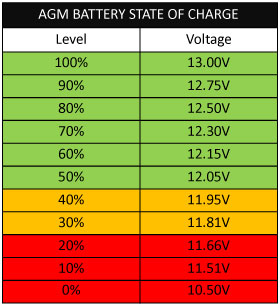There is no such thing as universal charging voltage. What changes is charging rate. Voltage at the terminals changes according to battery internal resistance while charging,resistance of everything else that charges it and state of charge.
Old-school BMW used constantly 13,7-13,9 as normal "charging voltage" at normal temperatures. If battery is depleted (and not sulfated) it would absorb charge at 100A rate easily for many minutes.
New Leaf + LeafSpy: I observe voltage data in LeafSpy that is comparable with multimeter on the terminals. I've heard that with older model it was not calibrated correctly.
When I said "it charges" I meant that current is flowing in the direction of battery at acceptable rate. Also Leaf does compensate charging voltage (your 13.1V) according to outside temperature (sensor is on 12V current sensor).
There are different types of lead acid batteries and there are different types AGM batteries. Those that have thicker electrode sheets and those that have thinner (for cranking).
Also batteryuniversity and other random sites do mention there are different "100% charged" voltages for AGM batteries (manufacturer based like I understood).
Newer BMW-s do have very smart BMS. In addition to start-stop BMW implemented EfficientDynamics at the beginning of this decade. This clever system keeps AGM battery charged at around 80%. During hard acceleration generator is disengaged. System voltage drops to 12-12,5 according to electrical load. And while decelerating generator is not just engaged, voltage regulator is set to 15,4V for maximum current flow. This results in regen at 3,5kW rate. This is possible as AGM battery is constantly kept at 80% during cruising. And sulfation is not a problem at that SOC (applies to AGM only) as those batteries last for many years (about 300-400Mm, Megametre, 1000km)
Of course sulfation is a huge problem. It is the main problem for any deep discharge scenario battery

If it doesn't spend any more time at 14.5V than I have specified, then it has problems.
I'm sure normal voltage I observe on BMW-s is enough, 13,7-13,9V (fluctuates due to temperature) to not let battery sulfate. Except that if it is drained during resting periods of 5 days. That is bad.
Random unverified data. I have OEM BMW battery available and it rests at 12.7V after a long week of float charge and a week of rest.
I will report back with 2014 Leaf voltages once I have some free time.
RegGuheert said:


